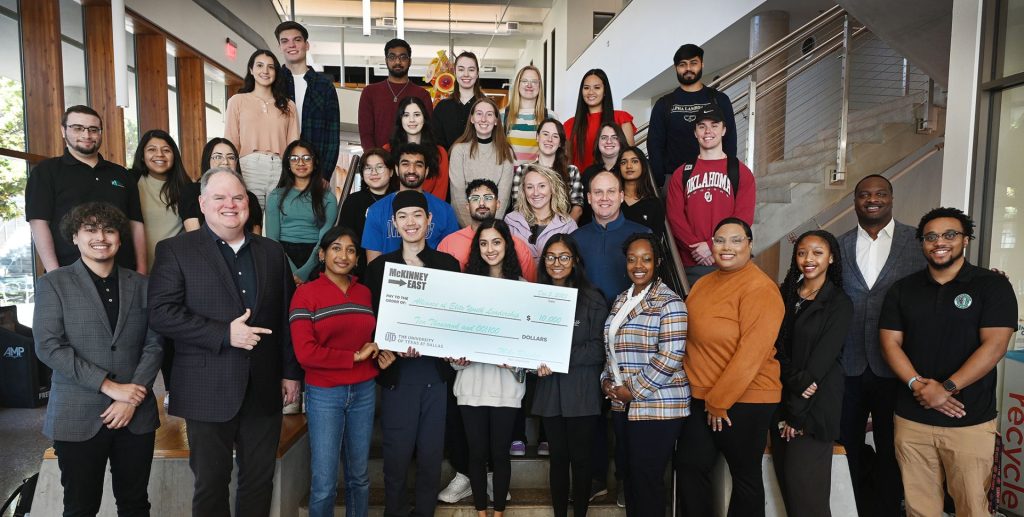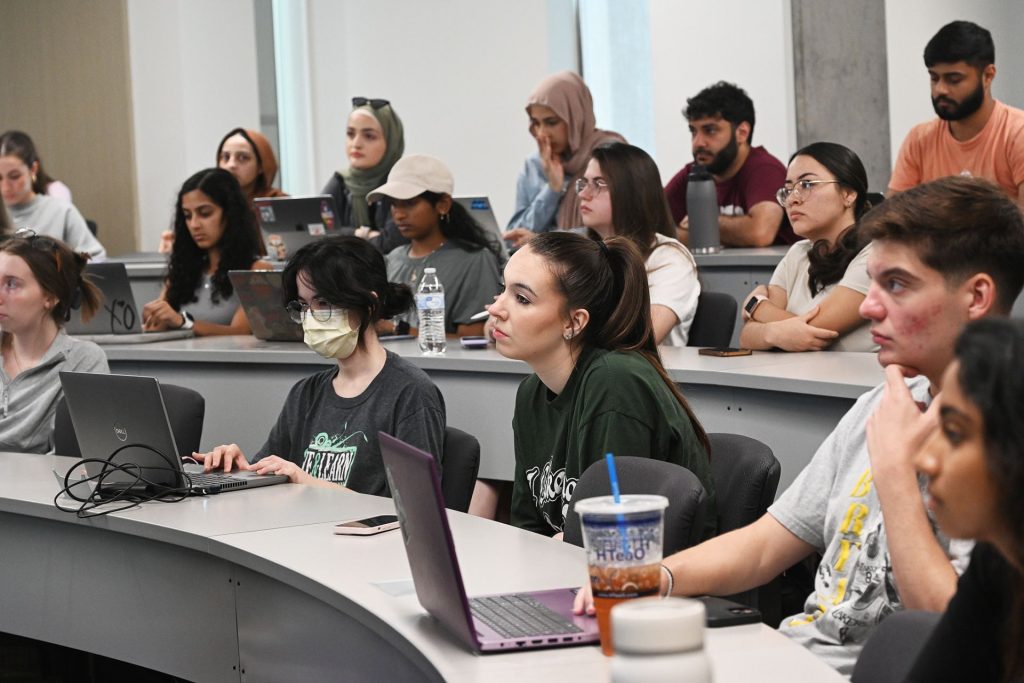Learning the Real-World Impact of Giving
By: Jeff Joiner | December 13, 2023

In an innovative class project in the Naveen Jindal School of Management at UT Dallas, undergraduate students competed for grant funding to support programming at the Alliance of Elite Youth Leadership (AEYL), a nonprofit based in McKinney, Texas. The real-world experience resulted in one student team winning $10,000 for the organization’s summer internship and apprenticeship program.
Students in the Management of Nonprofit Organizations class taught by Dr. Kyle Edgington worked in teams to produce a professional proposal based on course curriculum and industry best practices. The funding was provided by alumnus Mike Redeker MBA’97, MS’01 and his real estate development company McKinney East.
“When we visited AEYL we didn’t have a full idea of what we were exactly writing about, but personally I have always been really passionate about youth,” said Wilson Ly, a senior studying healthcare management and leader of the winning team. “What they do working with teenagers is really cool, and I came back and said we really need to prepare something good that’s going to be impactful for them and will really make a difference. I’m so proud that we were able to do that.”
Edgington has taught the undergraduate class for 10 years and also serves as vice president for development and alumni relations at UT Dallas.

“The course I teach examines the role that nonprofits play in today’s society and the challenges of leading and managing these unique organizations,” Edgington said. “We study a range of topics including leadership, mission, program evaluation, budgeting, marketing, fundraising, volunteerism and collaboration.”
In previous classes as part of the course’s fundraising section, Edgington assigned students to write mock grant applications to support nonprofits. But this year, with the help of Redeker, he was able to make the assignment an actual grant-writing exercise with real money at stake.
“McKinney East is awarding the grant to AEYL so all the students in the class will be able to participate in seeing how their team’s proposal seeks funding and how that process works choosing a winning application,” Edgington said. “This is as close to a real exercise as the students could possibly get.”
Redeker met with the class to explain the involvement of McKinney East and the importance of this opportunity for students to learn in a real-life exercise with actual implications for young people who participate in AEYL programs.
“This is a chance for you to focus on the impact that we have on our fellow human beings,” Redeker said. “If you impact a handful of people and those people impact a handful of people over the generations, you’re going to have a huge impact on society. A project like this gives you a chance to go change the world.”
AEYL founders Derrick and Ceretha Robinson also met with the students during their introduction to the assignment. After growing up in what the couple says is one of the poorest counties in Arkansas, the Robinsons started AEYL to develop programs to teach young people how to become successful community leaders.
“Where we came from, we didn’t have community resources. We didn’t have mentors; we didn’t have the best educators,” Derrick Robinson said. “So, we found our niche here in McKinney when we started AEYL, and that niche is serving teenagers.”
AEYL has launched several programs designed to give teens opportunities that the Robinsons say they never had growing up. The programs focus on leadership and life skills development and include summer internships and apprenticeships, career training, workforce placement, STEM and robotics exploration and community engagement initiatives.
The Robinsons are also raising money to build the AEYL Empowerment Center in McKinney, which Ceretha Robinson says will be a beacon for young people in the community. The center will include gym courts and space for community activities centered around AEYL’s programs.
During the grant award announcement, one of the students commented on how focused her teammates became on working to benefit AEYL. The student noted that a teammate at first said their priority was to receive an A grade in the class, but as they learned more about the mission of the nonprofit, the more interested they became in winning the grant for the organization’s benefit. The grade became secondary, the student said.
Each student team selected one of AEYL’s programs or the Empowerment Center on which to focus their grant application and then wrote proposals based on fundraising best practices introduced during the course. Teams researched their chosen programs and conducted site visits with AEYL’s staff to learn about the community impact of the nonprofit’s various programs.

“I love learning the how and why of theories, but actually applying what we learned in the class was really exciting,” said senior Sarah Gifford. “Not only getting to learn how to do grant writing but to actually write a grant and potentially helping a local nonprofit with such an impact was so amazing to me.”
Edgington said even if his business students decide not to go into the nonprofit sector as a career, they have learned to appreciate the fundraising process and the importance of measuring the influence of organizations.
“They learn just how competitive the nonprofit fundraising landscape is,” he said. “And they learn how to measure the efficacy of philanthropic dollars and if those dollars are making an impact because those dollars are scarce.”